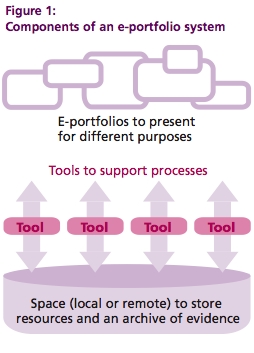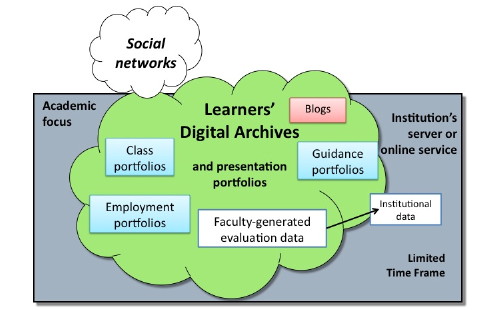MET:Introduction to Electronic Portfolios and their Potential Uses in Alternative Education Learning Environments
Introduction
“A portfolio tells a story. It is the story of knowing. Knowing about things... Knowing oneself... Knowing an audience... Portfolios are students' own stories of what they know, why they believe they know it, and why others should be of the same opinion. A portfolio is opinion backed by fact... Students prove what they know with samples of their work.(Paulson & Paulson, 1991)”
Electronic Portfolios, also referred to as e-portfolios are digitized collections of student work which are predominantly found published on the World Wide Web. E-portfolios are a type of learning record that charts student progress and overall academic growth. The process can also be used to chart emotional or social growth through the reflective process. An e-portfolio can contain a varied amount of content. Examples of content found in e-portfolios are webcasts, photos, essays, short stories, reflections, and links to on-line content. This wiki will examine the basics of e-portfolios and some of their potential uses in alternative education.
A portfolio is a combination of many different components (academic and reflective) which can vary depending on the desired outcome. The main focus of e-portfolios can be described as “...a collection of a learner’s work. From this collection, a learner selects certain pieces, depending on the purpose and audience, to go into a presentation format, and reflects on why that work was chosen. (Barret and Garret, 2009)” It has been shown that electronic portfolios can assist with the reflective process because they encourage the student to think critically about their work. “Portfolios prompt students to look back, to digest and debrief, and to review what happened so that they can set new goals and determine next steps. (Camp, 1992)”

 (Barret and Garret, 2009)
(Barret and Garret, 2009)
The E-portfolio Creation and Process
The process of creating a proper academic electronic portfolio consists of the following stages. (Abrami and Barret, 2009)
(1)collection
(2)selection
(3)reflection
(4)evaluation
(5)celebration
In the collection stage students and teachers collect various artifacts to be included in the container (e-portfolio). This usually consists of academic work, reflections and other information such as artwork or articles representative of the student. This information usually contains work that the student is proud of and reflective of the goal of the e-portfolio. The Selection stage involves taking the collected information and deciding which pieces are to be placed into the container. The student then reflects about their thinking and feelings about each selected piece. This is the reflective stage. The students then compare their finished product with their initial thoughts, this is the evaluative stage. The celebration stage is simply the presentation of the finished product with their peers. This can also be referred to as a showcase portfolio.
“EP's have three broad purposes: process, showcase and assessment. (Abrami and Barret, 2009)” The process component consists of the 5 stages previous listed. It can be viewed as the creation of a collection of student work that charts previous agreed on objectives. This can contain work that charts student effort, progress and achievement. The showcase portfolio is shared with other students and peers. “Demonstration” is the key concept in showcase portfolios as they illustrate what has been learned and do not merely describe what has been learned. (Abrami and Barrett, 2008)” An assessment portfolio's main focus is to provide a evaluative product for the student.
Uses and Implementation in the Alternative School Setting
One benefit to the e-portfolio process is the ability to combine academic classes with the portfolio process. For example, in an alternative education stream, one can use e-portfolios to track emotional growth through the reflective process. This can be combined with classes such as English, or social studies by requiring the students to meet certain academic guidelines when creating their reflections and creating their academic component.
In providing feedback to the reflective process, the educator is able to assess a variety of contexts of students progress. It is important that educators in this situation understand that we are empowering the students by allowing them to work in a setting that they are comfortable in. This with assist them in their future endeavors. “Paramount to this discussion is that students are developing dual digital literacies in the modern networked environment. (Alexander, 2006)”
Some e-portfolio benefits are the empowerment of students. “Learners, who act self-regulated, rehearse and use learning strategies, monitor their comprehension along with their beliefs about self-efficacy, learning outcomes, and perceived value of learning. (Neumann and Oberhuemmer)” This will only add to student confidence, independence and success when done correctly.
These benefits do coincide with many alternative environment philosophies . One example is Windsor House in North Vancouver. “Intrinsic motivation is highly valued at Windsor House, so staff do not offer external rewards such as letter grades or special praise. Instead, students work with family and staff to build learning portfolios that are reviewed during several conferences throughout the year. ("About Us" http://whs.at.org) In this circumstance electronic portfolios are an ideal container for student work because of the increased self efficacy the students develop. Students are then encouraged to present their portfolios at showcase events. This can be seen as a continuation of the celebration stage and adds to the students sense of academic empowerment.
 (Barret and Garret, 2009)
(Barret and Garret, 2009)
Criticism
When e-portfolio management systems are institution-centered, they are usually limited by the time constraints of the course, thus the content tend to be focused on meeting specific academic goals. This is not the ideal for a plethora of learners who learn in different ways. This does not foster creativity. One needs to also remember that learning is lifelong. “There is a need to separate the needs of the individual (for a personal learning space, to collect both the artifacts and a learner’s reflections on their learning over time) and the institution (for data about student learning/achievement, and the presentation portfolios created for institution-determined purposes). (Barret and Garrett, 2009)”
Another critique is the difficulty involved for teachers to maintain and facilitate the construction of electronic portfolios. They are still in their relative infancy and without the ongoing support from administrators the extra work involved in their maintenance often leads to educators abandoning the project. The creation of electronic portfolios can be very time consuming to both the educator and student. “Because teachers are frustrated with extra responsibilities, this can impact the effectiveness of the portfolio. As a consequence, teachers will not make any essential changes or put in too much effort to the implementation of the portfolio... (Newman, Smolen & Lee 1995)”
Without the proper technology education and tools electronic portfolios may not be an accurate indicator of student growth and progress. “An important drawback is the limitation to students who are illiterate in technology. Students also need to have the right equipment and software in order to work on the e-portfolio. Moreover students may spend a lot of time focusing on the design rather than on the content of the portfolio. (Lau 2005)” It is very important for educators to have a strong understanding of the e-portfolio process in order to prevent these problems.
References and Resources
Lau, S. (2005). The Implementation of Portfolio Assessment in an ESL/EFL Classroom. Retrieved June 21, 2008, from http://web1.hpu.edu/images/GraduateStudies/TESL_WPS/05Lau_Portfolio_a16709.pdf
Paulson, P.R., & Paulson F.L. (1991, March). Portfolios: Stories of knowing. Paper presented at the 54th annual meeting of the Claremont Reading Conference. (ERIC Document Reproduction Service No. ED377209)
Camp, R. (1992). Portfolio reflections in middle and secondary school classrooms. In K.B. Yancey (Ed.), Portfolios in the writing classroom (pp. 61–79). Urbana, Illinois: National Council of Teachers of English.
Barret, Helen. & Garrett, Nathan. (2009). Online Personal Learning Environments: Structuring Electronic Portfolios for Lifelong and Life Wide Learning. On the Horizon | Vol. 17 No. 2, 2009, pp. 142-152, © Emerald Group Publishing Limited, ISSN 1074-8121. Located at http://docs.google.com/Doc?id=dd76m5s2_39fsmjdk
Alexander, B. (2006) Web 2.0: A new wave of innovation for teaching and learning? EDUCAUSE Review, 41(2), 34-44. Accessed online 2 March 2009. http://www.educause.edu/ir/library/pdf/ERM0621.pdf
Abrami, P., & Barrett, H. (2008). Directions for Research and Development on Electronic Portfolios. Canadian Journal Of Learning And Technology / La Revue Canadienne De L’Apprentissage Et De La Technologie, 31(3). Retrieved March 8, 2010, from http://www.cjlt.ca/index.php/cjlt/article/view/92/86
Newman, C., Smolen, L, & Lee, D. J. (1995). Implementation of portfolios in an ESL classroom. Retrieved December 7, 2005, from (EBSCO) ERIC database (ED38464
Neumann, Susanne. Oberhuemer, Petra. Early Learner Empowerment by Means of Eportfolio. University of Vienna.
Recommended sites:
Portfolio Process: http://www.qesn.meq.gouv.qc.ca/Portfolio/eng/about.html
Desire 2 Learn Hosting: http://www.desire2learn.com/eportfolio/
Alternative Learning Environments: http://www.keystosaferschools.com/alemodel.htm
Windsor House, North Vancouver: http://whs.at.org